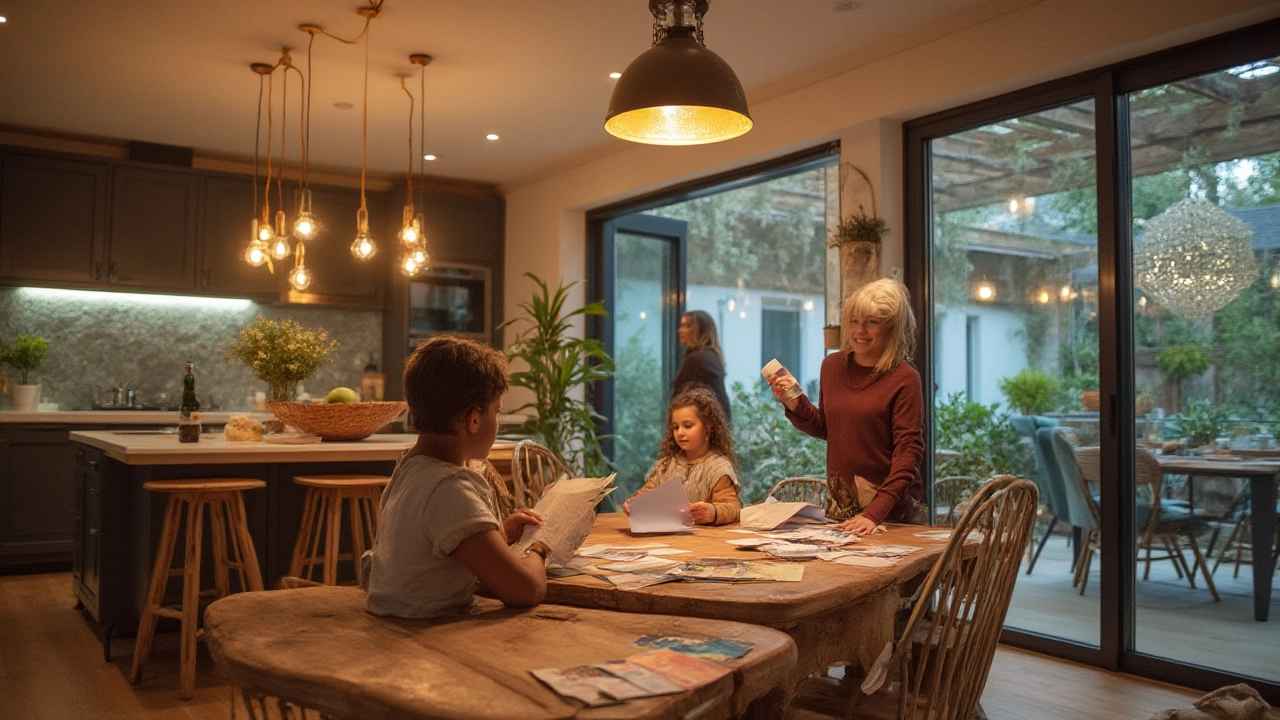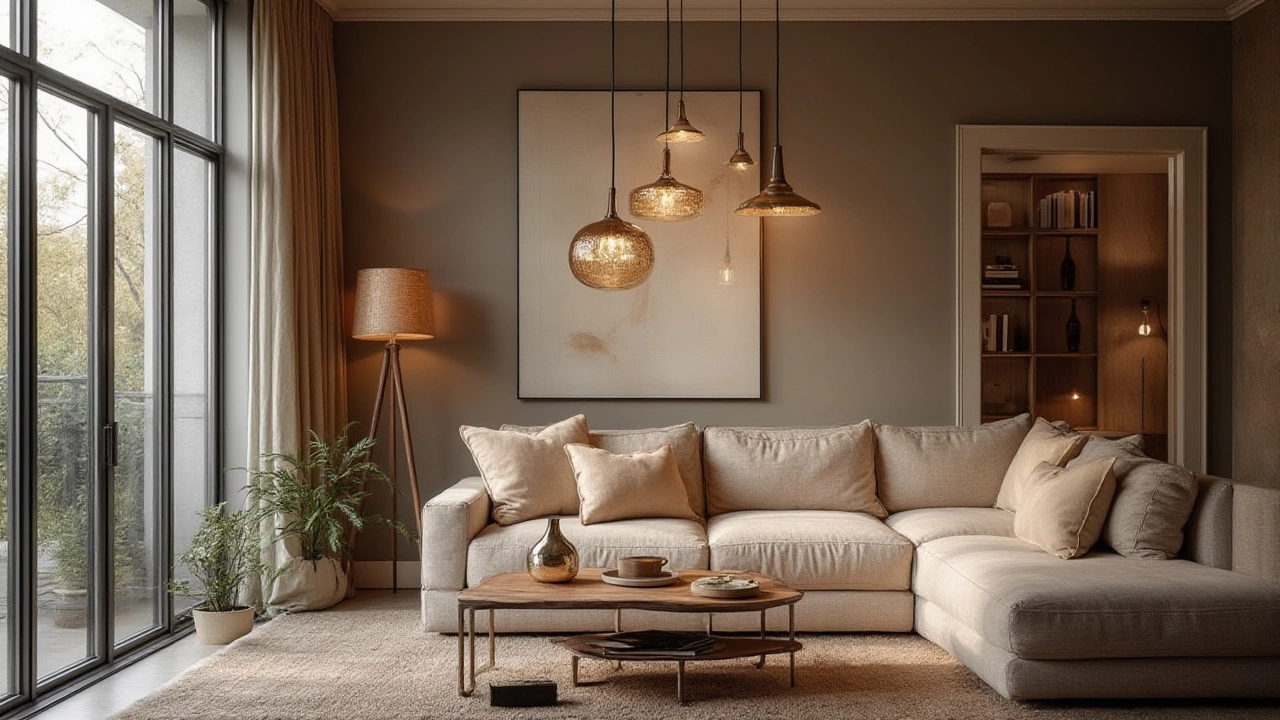If your home always feels a little off—and you’ve just splurged on new furniture and repainted every room—the culprit probably isn’t your sofa or paint job. It’s your lighting. Too bright in the living room, too dim at the desk, yellow where it should glow white—lighting quietly sets the mood, makes colors pop, and even shifts how big (or small) your rooms feel. Forget the old rule of one ceiling light per space; good lighting isn’t one-size-fits-all. Get this right, and your home finally clicks.
Understanding the Basics: Types of Lighting You Need
Lighting isn’t just about making things visible. Everything starts with the basics, and lighting types fall into three main camps: ambient, task, and accent. Ambient lighting’s your big-picture stuff—the stuff that makes it possible to navigate your kitchen without tripping on a stray Lego. It usually comes from ceiling fixtures or a solid pair of wall sconces. But heavy overhead lighting can leave things flat and harsh, so you’ll want to layer in other light sources for warmth and character.
Task lighting’s exactly what it sounds like: the direct beam where you need to actually get stuff done. Think kitchen under-cabinet lights (no more shadowy countertops) or a lamp over your favourite reading chair. Well-placed task lights can help prevent eye strain and can even make hobbies like crafting, cooking, or jigsaw puzzles a lot more enjoyable.
Accent lighting is the fun one. This is your chance to spotlight a gorgeous plant, a piece of art, or to add drama with a strip of LED under a pedestal or shelf. People often skip this step and regret it—accent lighting’s what makes a house feel memorable and lived in.
If you’re aiming for light that feels natural and inviting, pay attention to colour temperature. Warm lighting (around 2700-3000K) calms things down and works wonders in bedrooms and lounges. Cool white (close to 4000K) energises a space, making it a winner in home offices or kitchens. And natural daylight bulbs (5000K and up) are often top picks for daily makeup routines or anywhere precision matters.
The real trick? Mixing and matching types and temperatures so your space adapts with your mood, activity, and even the time of year. Don’t settle for a single blaring fixture and think the job’s done!
Room by Room: Tailoring Lighting to the Space
Let’s get practical. Start with the living room—the heart of most homes. This space juggles everything: Netflix marathons, board games with friends, even late-night work emails. You need layers here. A central fixture sets the tone (think pendant or flush mount), but layering in a few table lamps or floor lamps makes the space feel cozy after sundown. Even wall sconces, wired in or plug-in, work magic. Don’t forget dimmer switches—one of the best investments you’ll ever make for a Melbourne home where spring light changes by the minute.
Onto the kitchen. Ever tried chopping herbs in shadows? Under-cabinet lighting is your new best friend. Not only does it help with prep, but it makes your stone benchtop gleam after hours. Pendant lights work beautifully over kitchen islands, adding style and focused light for morning coffees or schoolwork catch-ups. Make sure cool or neutral white bulbs dominate here so everything looks crisp and clean.
Your bedroom? Keep it mellow. Steer clear of strong overheads—opt for warm, indirect lights. Wall-mounted lights or pendant lights by the bed free up your nightstand, plus adjustable reading lights prevent battles over who gets to turn the lamp off. Soft-glow bulbs (not higher than 3000K) work like magic for winding down, helping your brain make the switch from ‘go’ to ‘slow’.
Bigger bathroom renovations in Melbourne are using layered lighting for a spa feel—overhead lights for basics, but add vanity task lights that flank the mirror (not above it) to avoid weird shadows on your face. Waterproof LED strips on shelves, or even behind a mirror, make the room feel expensive—without the price tag.
Home offices often get left out—but if you’re still clutching that ancient desk lamp, it’s time for an upgrade. Go bright but not glaring. A desk light with adjustable temperature can help with focus during mornings and drop to warm glow for late tasks. One simple fixture won’t do; angle in at least one other source to get rid of eye-straining contrasts.

Choosing Fixtures: Style, Size, and Placement Matters
You can have the best bulbs in the world, but if you mess up on the fixtures, you’ll still feel…meh. Look at the style of your home—if you lean Scandinavian, go sleek and simple. Industrial interiors? Exposed bulbs and blackened metals add edge. Love a bit of whimsy? Glass globes or colourful pendants break the mould.
In Melbourne’s older homes, ultra-tall ceilings cry out for statement chandeliers (even if your room isn’t fancy—mixed styles look brilliant), while apartments with low ceilings call for flush mounts that don’t hog headroom. Always measure—photos online make fixtures look tinnier than they are. A light too big swallows a room; too small, and it gets lost. The right fixture should sit in harmony with the size of your table, sofa, or bed below. For dining tables, standard wisdom says your pendant should be about one-half to two-thirds the table’s width. Mind the gap—keep at least 75cm clearance between the tabletop and light base.
Placement is everything. Lights placed directly in line with where people sit, eat, or work help avoid uncomfortable glare. If you have art you’re proud of, picture lights are ideal. Want to highlight architectural features? Uplights and recessed lighting draw the eye exactly where you want it. If your hallway or entry feels dull, even a cheeky plug-in sconce can transform the walk to your front door.
Don’t forget about lampshades. Opaque ones focus the beam, while translucent shades scatter it all around. Go bold if your room needs a punch of personality, or choose muted tones to smarten up a neutral palette.
Working with Natural Light: The Unsung Hero
Living in Melbourne means wild weather and sunlight that can feel dazzling in one moment, gone the next. Harnessing natural light is less about luck than strategy. Sheer curtains work wonders, letting in sunlight while stopping glare. Large mirrors bounce daylight deeper into gloomy corners, making small rooms feel generous. If you have windows with a view, keep surrounding light fixtures subtle so nothing competes with mother nature.
For south-facing rooms (the classic cold, darker sides in Australia), bounce as much outdoor light as possible using pale paint, reflective tiles, or even metallic accents. Avoid blocking windows with heavy furniture—every stray centimetre makes a difference. Skylights or solar tubes give stubbornly dim rooms a daylight boost; even a well-positioned glass pane in an internal door helps.
Keep your layout flexible. Many homes in the city now use portable lights, such as battery-powered table lamps or cordless lanterns, that can move with you as the sun shifts during the day—especially handy for apartments, rentals, or anyone with commitment issues when it comes to interior design.
And remember, no matter how good your electric lighting is, nothing beats natural daylight for reading, relaxing, or energy. Blending natural and artificial light gives your rooms depth and keeps things from feeling one-note, whether you’re lucky enough to catch Melbourne’s golden hour or stuck in gloom by 4pm in winter.

Lighting Mistakes to Avoid and Pro Tips for Homeowners
It’s super common to get carried away by a pretty lamp or a mega sale. But if the light’s wrong, no bargain’s going to fix that. Trust me, I’ve brought home a sculptural pendant that looked amazing in the shop’s showroom—only for it to glare painfully above our dinner every night. Here’s the stuff that’ll save you the headache:
- Don’t use the same colour temperature in every room. Uniform lighting makes homes feel clinical—mix it up for comfort and function.
- Check your bulbs before tossing out fixtures. Sometimes, a new smart bulb with dimming and colour-changing magic brings a boring lamp back to life.
- Never rely solely on overhead lighting. At least two to three additional light sources in every room create the right mood—even in tiny flats.
- Match the lighting wattage to what you’re doing. Studies show that working in a space that’s too dim can increase fatigue, while glaring lights raise stress levels. Keep task lights brighter, but use dimmers to control the vibe elsewhere.
- Always consider the room’s natural light before buying new fixtures. It’s tempting to splurge on that industrial floor lamp, but if your dog naps in the sun right next to it all day, you won’t need another source till the sun sets.
- Group lights with smart systems, timers, or voice control if you like convenience. It may sound futuristic, but in Melbourne where people love tech, it’s quickly becoming the norm.
- Kids’ rooms—go for layered lighting and avoid fixtures with breakable glass or hard-to-reach switches. Remote-controlled night lights are a lifesaver for midnight wake-ups.
- Don’t ignore the exterior. Porch lights don’t just look better—they’re proven to deter opportunistic burglars, especially with options on motion sensors or solar power. It’s the sort of peace of mind that pays for itself.
When in doubt, play with lamps you already own before drilling or rewiring anything. Borrow a lamp from one room and try it in another—sometimes all it takes is a move to see a space in a whole new light. (Yes, pun absolutely intended).
And if you ever feel stuck, remember: lighting design isn’t about rigid rules. It’s about fixing shadows, highlighting what you love, and building a space that feels comfortable, inviting, and unmistakably yours. The best lighting plan grows with your home and never stops evolving. That’s what really makes a house shine.


